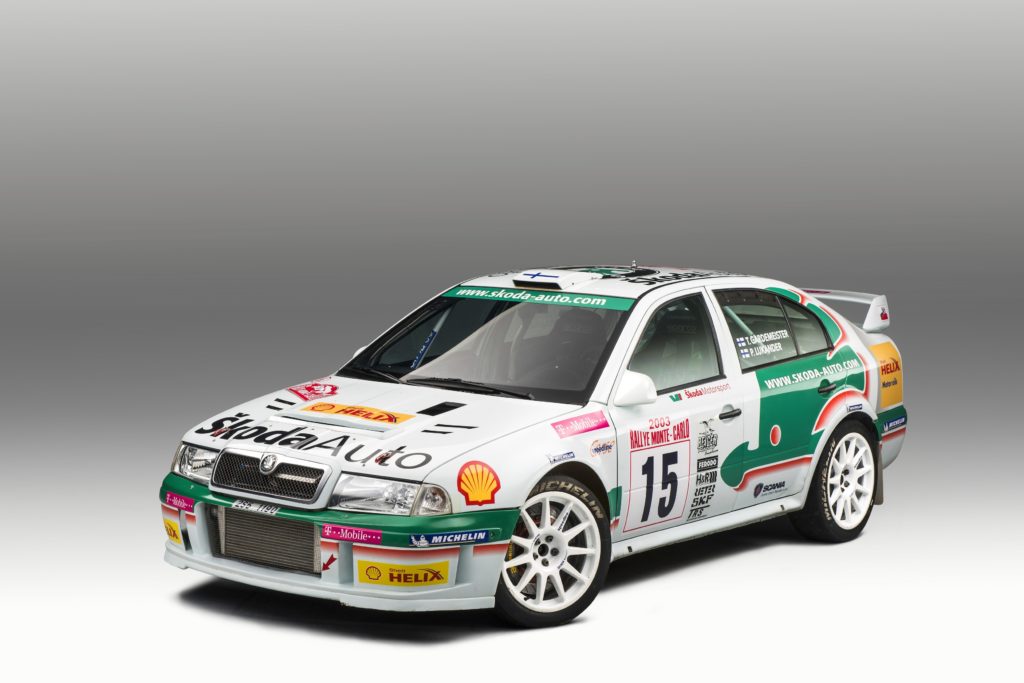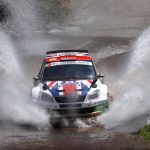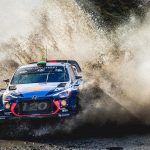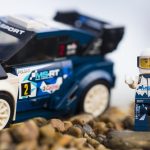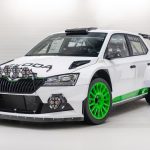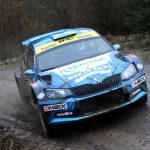Škoda celebrates a quarter of a century of competition in the FIA World Rally Championship (WRC). The new season kicks off this weekend with the Rallye Monte-Carlo (25-28 January), covering 17 stages and 324 kilometres of Alpine roads north of the Principality. Swedish Oliver Solberg and British co-driver Elliott Edmondson lead team Škoda in the Fabia RS Rally2.
Having come away with the WRC2 Drivers’ title with Andreas Mikkelsen in 2023, Škoda Motorsport is looking for further success in the 2024 motorsport season. The 92nd Monte Carlo Rally is the first event of the new WRC season, with the duo of Oliver Solberg and Elliott Edmondson most recently announced as pilots of the Fabia RS Rally2 in WRC2.
History of Škoda Rally Cars
Octavia WRC – 1999
After a year-long test and development schedule, Škoda Motorsport debuted the all-new Octavia WRC at the Rallye Monte-Carlo in 1999. The Škoda Octavia WRC was powered by a turbocharged two-litre engine with five-valve technology. It produced 221 kW (300 hp); the torque was initially 500 Nm at 3,250 rpm, subsequently rising to 600 Nm. The car’s kerb weight was 1,230 kg, which was the minimum specified in the regulations. In combination with all-wheel drive, this made the Octavia WRC the most dynamic racing car up to that point in Škoda’s motorsport history.
At the last race of 1999 season Belgian, Bruno Thiry, almost achieved a podium finish, placing fourth overall. Within just one season, the Octavia WRC had progressed from being an absolute newcomer on the grid to a formidable contender. The Octavia WRC competed for a further three and a half years, retiring in the 2003 season with a best finish of third at the 2001 Safari Rally, courtesy of Armin Schwarz.
Fabia WRC – 2003
Taking over from the Octavia was the Fabia WRC, which made its first competitive start at Rally Germany.
The Škoda Fabia WRC – unlike its series-production counterpart – was powered by a turbocharged, water-cooled four-cylinder petrol engine with a displacement of two litres. Its output was 221 kW (300 hp), with a maximum torque of 600 Nm. The power was transmitted to all four wheels via a sequential six-speed gearbox and three active differentials. The McPherson suspension included wishbones at the front and two wishbones and one trailing arm at the rear, while disc brakes on every wheel ensured reliable deceleration. Due to the regulations, Škoda also installed a modified front bumper in the series-production Fabia RS for homologation purposes, increasing the overall length of the vehicle beyond the four-metre mark as was required.
A notable result came in 2005 from one of WRC’s best-known characters and 1995 champion, the late Colin McRae. At Wales Rally GB he secured seventh in the Fabia, and at the final event of the year in Australia was running in second overall before a problematic clutch change caused his retirement.
Škoda withdrew at the end of 2005, with two private teams competing with Factory support in 2006 and 2007 with the Fabia WRC.
Fabia S2000 – 2009
2009 was a breakthrough year for the Mladá Boleslav team, when the Škoda Fabia S2000 project, based on the second generation Fabia, was started. With this project, Škoda Motorsport entered the World Rally Championship (PWRC category) and the Intercontinental Rally Challenge (IRC) for the first time. At the same time it launched a modern customer programme that is undoubtedly one of the most successful to date.
A total of 63 Fabia S2000 models made it to customers as racing specials, with which they managed to win 50 national and international titles. The factory team was also very successful at this period, thanks to the trio of Juho Hänninen, Jan Kopecký and Esappeka Lappi.
Andreas Mikkelsen was crowned the 2011 Intercontinental Rally Challenge drivers’ champion, after winning the Cyprus Rally in his factory-prepared Škoda UK Motorsport Fabia S2000.
Although the Škoda Fabia S2000 set the bar very high with its achievements, its successor, the Škoda Fabia R5, managed to surpass it handily and went down in history as the most successful project ever.
Fabia R5, R5 Evo, Rally2, Rally2 Evo – 2015
In 2015, R5 regulations succeeded those of S2000, with the WRC2 championship replacing the SWRC and using the same calendar and stages as the WRC.
To continue competing Škoda needed a new car, the Fabia R5. It had a specially designed 1.6-litre turbocharged engine, producing 282 hp and 420 Nm of torque. It also had a four-wheel-drive system, rally-spec McPherson suspension and a five-speed sequential gearbox.
The Fabia R5 proved to be class-leading, with a superb second place overall at the car’s first rally in Portugal in 2015. Škoda Motorsport achieved the WRC2 Teams’ titles in 2015, 2016, 2017 and 2018, plus Drivers’ titles in those years as well as 2019 and 2021. In that time the Fabia R5 evolved mechanically into the R5 Evo, which was later renamed the Fabia Rally2 Evo as the rule set was given a new title.
More than 450 third-generation Fabia rally cars were built, from the R5 to the Rally2 Evo, making it not only the most successful Škoda rally car ever but also the best-selling.
Fabia RS Rally2 – 2023
Following in the tyre tracks of the Fabia R5 Evo was the Fabia RS Rally2, unveiled in June 2022. The RS Rally2 benefits from a 1.6-litre turbocharged four-cylinder engine with 289 hp, improved aerodynamic performance, a redesigned five-speed sequential gearbox and four-wheel-drive system, upgraded durability and, most importantly for any rally car, improved safety. The car benefits from six layers of carbon-fibre and Kevlar to protect the driver and co-driver from side impacts, with a layer of impact-absorbing foam offering further protection.
Andreas Mikkelsen, at the wheel of the Fabia RS Rally2 in 2023, took four wins and one third place on his way to the Drivers’ title, 33 points clear of second place.
Also in 2023 but away from the WRC, Sébastien Loeb, the most successful WRC driver of all time with nine world championships, drove a Škoda for the first time in competition at the Azores Rallye, the third round of the 2023 Tour European Rally, winning by 19.2 seconds.
2024
With 13 rounds scheduled for the 2024 WRC season, and the season-opening Rallye Monte-Carlo Rally from January 25-28, Škoda Motorsport will compete once more on some of the toughest rally stages in the world, but it will do so in a more sustainability conscious way.
The fuel system of the RS Rally2 has been designed to run on fossil-free, carbon neutral P1 WRC fuel. In addition, replacing bubble wrap for paper padding for spare parts cuts 180kg of plastic waste per year, with biocomposite car parts reducing the environmental impact further.
